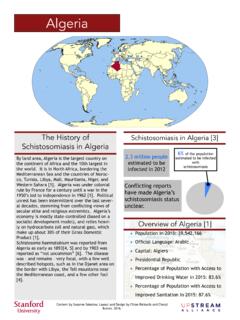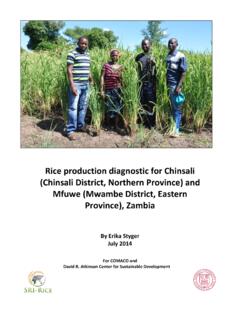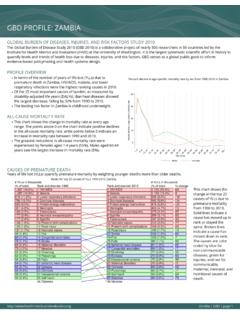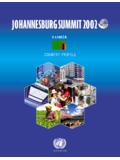Transcription of Zambia - Stanford University
1 Zambia Zambia is a landlocked country in Africa, with a southern border formed by the Zambezi River and its reservoir above the Kariba dam, Lake Kariba [1]. The Lake Kariba reservoir, the larg-est in the world by water volume, also forms Zimbabwe s northern border with Zambia , and as a result, the two countries share a problem of Schistosoma mansoni transmission concen-trated around the lake[2]. S. haematobium is more common and widespread than S. mansoni throughout Zambia and has been prevalent in all provinces of the country [3, 4].Schistosomiasis records in Zambia date back at least to the mid 19th century when the mission-ary explorer, David Livingstone, died in swamps south of Lake Bangweulu in Zambia - possibly of hemorrhage as a sequella to schistosome (and/or other parasitic) infections [5]. During the 20th century Zambia and the Zambezi River have been sites of numerous studies about, but little coor-dinated control for, schistosomiasis [2, 3, 6-16].
2 The first officially-recorded case of schistosomi-asis in Zambia was in 1908 [4]. The most recent estimate of schistosomiasis prevalence in Zambia places the country at nationwide in 2012 [17]. 1995, in 2003, and in 2010. The History of Schistosomiasis in Zambia Population in 2015: 15,066,266 Official Language: English Capital: Lusaka Presidential Republic Percentage of Population with Access to Improved Drinking Water in 2015: Percentage of Population with Access to Improved Sanitation in 2015: of Zambia [1]Schistosomiasis in Zambia [22]Almost half a million people required treat-ment in 2014In 2014, of the population requiring preventative chemotherapy were school-aged of the popula-tion requires preventa-tive chemotherapy for schistosomiasisContent by Susanne Sokolow and Chloe Rickards. Layout and Design by Chloe Rickards and Lee Marom.
3 Has hardly changed from estimates from the last few decades of in 1986; in 1995, in 2003, and in 2010. [18-20]1. The World Factbook. 2013-14 [cited 2015 Oct]; Available from: Chimbari, , et al., Transmission of schistosomiasis in Kariba, Zimbabwe, and a cross-sectional comparison of schistosomiasis prevalences and intensities in the town with those in Siavonga in Zambia . Ann Trop Med Parasitol, 2003. 97(6): p. 605-16. 3. Kabatereine, , et al., The control of schistosomiasis and soil-transmitted helminths in East Africa. Trends Parasitol, 2006. 22(7): p. Doumenge, , et al., Atlas of the global distribution of schistosomiasis, 1987, World Health Orgnaization: Geneva, Switzerland. 5. Barrett, M. What is David Livingstone s legacy, 200 years after his birth? 2013 [cited 2015 November]; Available from: 6. de Jonge, N. and van Vliet, Urinary schistosomiasis in the Sichili Health Zone, Western Province, Zambia .
4 Trop Med Parasitol, 1991. 42(3): p. Hira, , Seasonal population densities of snails transmitting urinary and intes-tinal schistosomiasis in Lusaka, Zambia . Trop Geogr Med, 1975. 27(1): p. 83-92. 8. Mwanakasale, V., et al., Impact of iron supplementation on schistosomiasis control in Zambian school children in a highly endemic area. Malawi Med J, 2009. 21(1): p. Mwanakasale, V., et al., Interactions between Schistosoma haematobium and human immunodeficiency virus type 1: the effects of coinfection on treatment outcomes in rural Zambia . Am J Trop Med Hyg, 2003. 69(4): p. Ng andu, , Nkowane, and Watts, The health status of rural prima-ry schoolchildren in Central Zambia . J Trop Med Hyg, 1991. 94(3): p. Phiri, , et al., Trematode infections in freshwater snails and cattle from the Kafue wetlands of Zambia during a period of highest cattle-water of Helminthology, 2007.
5 81(1): p. Rollinson, D., Biochemical genetics in the study of schistosomes and their inter-mediate hosts. Parassitologia, 1985. 27(1-2): p. 123-39. 13. Siziya, S. and M. Mushanga, Importance of schistosomiasis in the Isoka district of Zambia : a prerequisite for its control using community participation. Soc Sci Med, 1996. 42(3): p. Sukwa, , A community-based randomized trial of praziquantel to control schistosomiasis morbidity in schoolchildren in Zambia . Ann Trop Med Parasitol, 1993. 87(2): p. Sukwa, , Bulsara, and Wurapa, Reduction in prevalence, intensity of infection and morbidity due to Schistosoma mansoni infection in a community following treatment with praziquantel. J Trop Med Hyg, 1987. 90(4): p. 205-11. 16. Sukwa, , Bulsara, and Wurapa, The relationship between morbidity and intensity of Schistosoma mansoni infection in a rural Zambian community.
6 Int J Epidemiol, 1986. 15(2): p. Lai, , et al., Spatial distribution of schistosomiasis and treatment needs in sub-Saharan Africa: a systematic review and geostatistical analysis. Lancet Infect Dis, 2015. 15(8): p. Rollinson, D., et al., Time to set the agenda for schistosomiasis elimination. Acta Trop, 2013. 19. Utroska, , et al., An estimate of the global needs for praziquantel within schistosomaisis control programs, 1989, World Health Organization: Geneva, Switzerland. 20. Chitsulo, L., et al., The global status of schistosomiasis and its control. Acta Trop, 2000. 77(1): p. Fenwick, A., The control of schistosomiasis in Africa and the evaluation of integrated control of neglected tropical diseases in Africa, 2011, Bill & Melinda Gates Foundation: Global Health Final Reports Grant ID# 13122 and 36202. 22. WHO. PCT databank. [cited 2015 Oct].ReferencesHistory by Susanne Sokolow and Chloe Rickards.
7 Layout and Design by Chloe Rickards and Lee Marom. first National Plan of Action for schistoso-miasis control in Zambia was initiated in 1998, but it wasn t until the year 2000 that the Zam-bian government s School Health and Nutrition program distributed praziquantel as part of their integrated anti-helminthic and education campaigns in government schools[3]. Roll out of praziquantel distribution was relatively slow in the Zambian School Health and Nutrition program. It is unclear how many children were treated with praziquantel in the first five years. The aims of this program were multifaceted and included many more goals than just schistosomi-asis control, such as HIV/AIDS education, gender issues, water and sanitation, and treatment of soil-transmitted helminthes [3].From 2004 to 2005, theZambian Bilharzia Control Programme (ZBCP) spun off the School Health and Nutrition program as a partnership between the Schistosomiasis Control Initiative (SCI, fund-ed by the Bill & Melinda Gates Foundation), the Zambian Government, and the World Health Organization (WHO), with the new goal of treat-ing 75% of school-aged children and reaching all communities with >50% prevalence via prazi-quantel-based mass drug administration (MDA) campaigns.
8 An SCI report to the B&M Gates Foundation in 2011, explains that despite lofty goals, implementation in Zambia fell short of expectations, mainly due to poor communication and lack of buy-in from the centralleadership at the ZBCP and from district health teams [21]. Following these initial efforts, SCI backed drug administrations during 2005-6 and 2010, but the programs reached less than 5% of the population in need each year, according to WHO records [3, 22].Schistosomiasis Control inZambia










